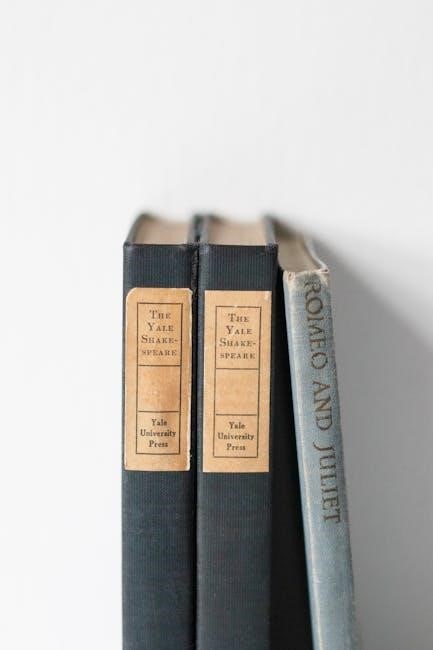Romeo and Juliet, a timeless tragedy by William Shakespeare, explores the devastating feud between the Montagues and Capulets in Verona, highlighting star-crossed lovers’ ultimate sacrifice.
1.1 Overview of the Play
Romeo and Juliet, set in Verona, revolves around the bitter feud between the Montagues and Capulets. Against this backdrop of hatred, Romeo, a Montague, and Juliet, a Capulet, fall deeply in love. They secretly marry with Friar Laurence’s help, hoping to end the conflict. However, when Tybalt kills Mercutio, Romeo avenges his friend, leading to his banishment. Juliet fakes her death to avoid another marriage, but Romeo believes she is truly dead and poisons himself in her tomb. Juliet awakens to find Romeo dead and stabs herself with his dagger, uniting them in tragic fate. The play explores themes of love, hate, and destiny.
1.2 Historical Context and Significance
Romeo and Juliet, written by William Shakespeare around 1595, is set in Renaissance Verona, reflecting the era’s societal norms and family feuds. The play draws inspiration from ancient narratives, such as Arthur Brooke’s poem, to craft a universal tale of love and conflict. Its enduring popularity stems from its exploration of human emotions and the timeless struggle between fate and free will. The tragedy has become a cultural cornerstone, influencing countless adaptations and interpretations across literature, theater, and film, solidifying its place in global artistic heritage.

Plot Summary of Romeo and Juliet
Set in Verona, the tragic tale unfolds amid a bitter feud between the Montagues and Capulets. Two young lovers, Romeo and Juliet, secretly marry, leading to a heart-wrenching conclusion.
2.1 Acts 1-3: The Meeting and Secret Marriage
Romeo, a Montague, falls in love with Juliet, a Capulet, at a ball hosted by her family. Despite the families’ feud, they exchange vows of love. With the help of Friar Laurence, they secretly marry, hoping to end the conflict. Meanwhile, tensions rise as Tybalt, Juliet’s cousin, recognizes Romeo at the ball and vows revenge. The intensity of their families’ hatred and the rushed nature of their union set the stage for the tragic events that follow.
2.2 Acts 4-5: The Tragic Conclusion
In Act 4, Juliet fakes her death to avoid marrying Paris, but Romeo believes she is truly dead and poisons himself in her tomb. Juliet awakens to find Romeo dead and, in grief, stabs herself with his dagger. The tragic end of the lovers ultimately brings peace between their families, as they realize the senseless destruction caused by their feud. This poignant conclusion underscores the devastating consequences of impulsive actions and the redemptive power of love, leaving a lasting impact on the audience.

Major Characters in Romeo and Juliet

Romeo, a passionate Montague, and Juliet, a determined Capulet, are the tragic protagonists. Their families’ feud fuels the conflict, while Friar Laurence, Tybalt, and Mercutio play pivotal roles.
3.1 Romeo Montague: Characteristics and Development

Romeo, the son of Lord and Lady Montague, is a young, handsome, and sensitive man. Initially, he is infatuated with Rosaline, exhibiting his romantic and emotional nature. Upon meeting Juliet at the Capulet ball, his passion shifts, showcasing his impulsive and ardent personality. Throughout the play, Romeo evolves from a lovesick youth to a determined husband, willing to risk everything for Juliet. His loyalty and devotion highlight his growth, yet his impulsiveness also leads to tragic consequences, making him a complex and memorable character in Shakespeare’s timeless tragedy.
3.2 Juliet Capulet: Growth from Innocence to Maturity
Juliet, the daughter of Lord and Lady Capulet, begins as an innocent and naive young girl, obedient to her family’s wishes. Her initial subservience reflects her sheltered upbringing. However, upon meeting Romeo, Juliet’s character undergoes significant development. She transforms from a naive child into a mature and determined woman, willing to defy societal norms and family expectations for her love. Juliet’s courage and resilience are evident as she takes charge of her destiny, orchestrating her secret marriage and later devising a risky plan to avoid an arranged marriage. Her growth highlights her emotional depth and the tragic consequences of her choices.
3.3 Other Key Characters: Friar Laurence, Tybalt, and Mercutio
Friar Laurence, a wise and well-meaning Franciscan friar, plays a pivotal role in the story. He marries Romeo and Juliet in secret, hoping to end the feud between their families. Tybalt, Juliet’s cousin, is a hot-tempered and aggressive character who despises the Montagues and ultimately kills Mercutio in a duel. Mercutio, Romeo’s loyal and witty friend, brings comedic relief but also escalates tensions with his fiery personality. His death at Tybalt’s hand sparks a chain of tragic events, highlighting the destructive nature of the families’ hatred and the devastating consequences of impulsive actions.

Themes and Symbolism in the Play
Themes of love, hate, fate, and identity dominate the play, enriched by symbols like the balcony, representing longing, and the tomb, symbolizing tragic union and sacrifice.
4.1 Love vs; Hate: The Central Conflict
The feud between Montagues and Capulets fuels hatred, while Romeo and Juliet’s love transcends it, creating a tragic clash. Love becomes both their strength and ultimate demise.
4.2 Fate vs. Free Will: The Tragic Flaw
The interplay between fate and free will drives the tragic outcome of Romeo and Juliet. While their choices—such as the secret marriage and impulsive actions—shape their destiny, fate seems to steer their actions toward an inevitable conclusion. Romeo and Juliet’s decisions, influenced by passion and circumstance, highlight the tension between personal agency and the inevitability of their doom. This duality underscores Shakespeare’s exploration of human responsibility and the forces beyond control that lead to tragedy.
4.3 Symbols in the Play: The Balcony, the Dagger, and the Tomb
The balcony symbolizes the lovers’ longing and separation, representing the divide between their families’ feud and their private love. The dagger embodies the violent conflict and tragic fate, foreshadowing the play’s deadly outcome. The tomb, where the lovers ultimately reunite in death, signifies their eternal union and the devastating cost of their families’ hatred. These symbols underscore themes of love, violence, and inevitability, enriching the play’s emotional and thematic depth.

Historical and Cultural Context
Set in Verona during the Renaissance, Romeo and Juliet reflects societal norms of family honor and loyalty, drawing inspiration from Italian sources and earlier adaptations of the tale.
5.1 The Setting: Verona, Italy, and the Feud
The story unfolds in Verona, Italy, a city steeped in history and culture. The ancient feud between the Montagues and Capulets dominates the social landscape, shaping the characters’ actions and the tragic outcome. The city’s picturesque setting contrasts sharply with the violence and animosity between the two families, highlighting the destructive nature of their rivalry. Verona’s streets and landmarks, such as the Capulet ball and the tomb where the lovers ultimately meet their fate, serve as poignant backdrops to their doomed love story. The feud’s origins are shrouded in mystery, adding depth to the conflict’s enduring legacy.
5.2 Shakespeare’s Sources: Adaptation of Earlier Works
Shakespeare’s Romeo and Juliet draws inspiration from earlier literary works, including Arthur Brooke’s narrative poem The Tragicall Historye of Romeus and Juliet and Matteo Bandello’s Italian novella. These sources provided the framework for the tragic love story, with Shakespeare adapting the plot, characters, and themes to suit his dramatic style. While the core narrative remains faithful to its origins, Shakespeare’s mastery of language and emotional depth transformed the tale into a timeless masterpiece. His adaptation not only enhanced the emotional complexity of the characters but also elevated the story’s universal appeal, ensuring its enduring relevance in literature and theater.

Reception and Legacy
Romeo and Juliet has become a timeless classic, captivating audiences with its universal themes of love and conflict. Its enduring popularity has inspired countless adaptations and interpretations.

6.1 Popularity and Enduring Appeal
Romeo and Juliet’s timeless appeal lies in its exploration of universal themes like love, family feuds, and fate. The play’s poetic language and relatable characters continue to captivate audiences globally. Its enduring popularity is evident in numerous adaptations, from classical theater to modern film interpretations. The tragic love story resonates across cultures, making it a cornerstone of literary and theatrical heritage. Its influence extends beyond the stage, inspiring art, music, and literature. The play’s ability to evoke deep emotions ensures its lasting relevance in contemporary society.
6.2 Cultural Impact and Modern Adaptations
Romeo and Juliet’s influence extends beyond literature, shaping art, film, and music. Modern adaptations like West Side Story reimagined the feud as a gang rivalry in New York City, while films such as Romeo + Juliet set the story in a contemporary Verona. The ballet adaptation by Sergei Prokofiev further cemented its cultural presence. These reinterpretations highlight the timeless themes of love and conflict, resonating with diverse audiences. The play’s adaptability ensures its relevance in modern storytelling, inspiring new generations to explore its universal themes through various mediums.
Educational Significance
Romeo and Juliet is a cornerstone of literary education, teaching critical thinking, empathy, and Shakespearean language, with its universal themes resonating across generations.
7.1 Role in Literary Education

Romeo and Juliet holds a pivotal role in literary education, offering insights into Shakespearean language, tragic structure, and universal themes like love and conflict. It introduces students to classical drama, enhancing critical thinking and empathy. The play’s exploration of human emotions and societal issues provides a rich foundation for analysis, making it a cornerstone in high school and college curricula. Its enduring relevance ensures that learners gain valuable perspectives on literature and life, fostering a deeper appreciation for the arts.
7.2 Discussion Questions for Students
Engaging discussion questions about Romeo and Juliet encourage students to delve into themes, characters, and moral dilemmas. Examples include: What role does fate play in the tragedy? How do Romeo and Juliet’s decisions reflect their maturity? How does the feud between families impact the characters? What lessons can be learned from their story? These questions prompt students to think critically about the play’s universal themes and their relevance to modern life, fostering meaningful dialogue and deeper understanding of Shakespeare’s masterpiece.
Romeo and Juliet remains a timeless tragedy, illustrating the devastating consequences of hate and impulsive decisions, leaving a lasting impact on literature and human emotion.
8.1 Final Thoughts on the Tragedy
Romeo and Juliet’s tragic end underscores the senselessness of their families’ feud and the devastating consequences of impulsive decisions. Their love, pure and intense, is ultimately destroyed by the hatred surrounding them. The play leaves a lasting reflection on the destructive nature of hate and the redemptive power of love. Shakespeare’s masterpiece continues to resonate, reminding us of the fragility of life and the inevitability of fate. The enduring appeal of this tale lies in its universal themes of love, loss, and the human condition.
